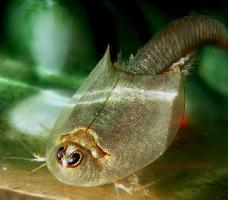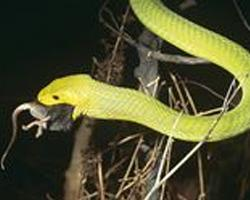
Súlyok és méretek
| Hossz | 60 mm |
|---|
Állatleírás
The American tadpole shrimp, scientifically known as Triops longicaudatus, is a fascinating species of freshwater crustacean belonging to the order Notostraca. This prehistoric creature, often dubbed a "living fossil," has remained virtually unchanged for over 200 million years, providing a unique window into the Earth's distant past. The name "Triops" is derived from Greek, meaning "three eyes," which accurately describes one of the creature's distinctive features—a pair of large compound eyes and a smaller, median ocellus situated between them.Triops longicaudatus has a broad, shield-like carapace that covers the front portion of its body, serving as protection against predators and environmental hazards. This carapace is often a muddy brown or greenish color, helping the shrimp blend into the bottoms of temporary pools and ponds where it typically resides. Beneath this shield, the creature's segmented body extends backward, culminating in a long, forked tail—hence the name "longicaudatus," which means "long-tailed." The body of the American tadpole shrimp can reach up to 7 centimeters (about 2.8 inches) in length, although sizes can vary depending on environmental conditions.
One of the most remarkable aspects of Triops longicaudatus is its method of reproduction and lifecycle, which has allowed it to survive through the ages. The species is known for its rapid development and ability to lay drought-resistant eggs, which can remain dormant for several years until conditions are favorable for hatching. These eggs can survive extreme temperatures and desiccation, springing to life when submerged in water. This adaptation enables the American tadpole shrimp to inhabit ephemeral water bodies, such as temporary ponds and vernal pools that form in arid and semi-arid regions after rainfalls.
The diet of Triops longicaudatus is as versatile as its habitat; these creatures are omnivorous and will consume a wide variety of organic material, including algae, detritus, and small invertebrates. They play a crucial role in their ecosystems, acting as both a predator and a scavenger, and thus contribute to the nutrient cycling within their aquatic environments.
Despite their ancient lineage and resilience, American tadpole shrimps face threats from habitat destruction and pollution. The temporary pools they inhabit are vulnerable to agricultural development, urbanization, and climate change, which can lead to the loss of critical breeding sites. Conservation efforts are essential to ensure the survival of these unique creatures and the ephemeral aquatic habitats they depend on.
In summary, the American tadpole shrimp, Triops longicaudatus, is a remarkable species that combines historical significance with ecological importance. Its unique physical characteristics, ancient lineage, and adaptive reproductive strategies make it a subject of interest not only for scientists and researchers but for anyone fascinated by the diversity and resilience of life on Earth.
Új állatfotók
Top 10 állat
- Dolphin gull (Leucophaeus scoresbii)
- Diana monkey (Cercopithecus diana)
- Moustached guenon (Cercopithecus cephus)
- Galápagos tortoise (Geochelone nigra complex)
- Stone loach (Barbatula barbatula)
- Japanese macaque (Macaca fuscata)
- Greek tortoise (Testudo graeca)
- Russian tortoise (Testudo horsfieldii)
- Common flying dragon (Draco volans)
- Galápagos penguin (Spheniscus mendiculus)


